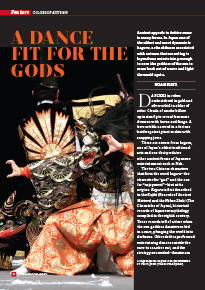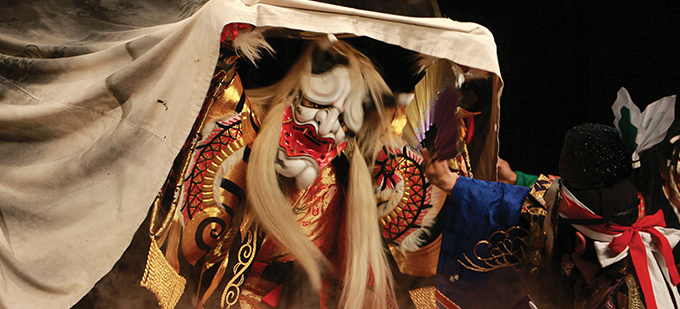Home > Highlighting JAPAN >Highlighting Japan November 2015>Colors of Autumn
Highlighting JAPAN

Colors of Autumn
A Dance Fit for the Gods
Ancient appeals to deities come in many forms. In Japan one of the oldest and most dynamic is kagura, a ritual dance associated with autumn that according to legend was entertaining enough to coax the goddess of the sun to come back out of a cave and light the world again.

Dancers in robes embroidered in gold and silver whirl in a blur of color. Clouds of smoke billow up instantly to reveal fearsome demons with horns and fangs. A hero wields a sword in a furious battle against giant snakes with snapping jaws.
These are scenes from kagura, one of Japan’s oldest traditional arts and one that predates other ancient forms of Japanese entertainment such as Noh.
The two Chinese characters that form the word kagura—the character for “god” and the one for “enjoyment”—hint at its origins. Kagura is first described in the Kojiki (Records of Ancient Matters) and the Nihon Shoki (The Chronicles of Japan), historical records of Japanese mythology compiled in the eighth century. These records tell of a time when the sun goddess Amaterasu hid in a cave, plunging the world into darkness. Other deities performed entertaining dances outside the cave to coax her out, and the strategy succeeded—Amaterasu found them so alluring that she gave up her sanctuary, and light returned to the world. This provided the inspiration for kagura.
Kagura’s original form traces its roots to Shimane Prefecture’s Izumo area, which was a center for Japanese culture and industry in ancient days. Seiji Ishii, director of the NPO Hiroshima Kagura Art Laboratory, explains that Shinto agricultural rituals influenced the dance. These rituals sought blessings from deities in nature for rice crops during the spring planting season, and expressed gratitude after a successful harvest in autumn.
“Japanese saw gods everywhere they looked,” says Ishii. “Big stones and big trees were all deities, and these were thought to play a role in the natural production of food.” In Izumo, kagura became associated with autumn festivals in particular as an offering of entertainment that Shinto priests performed for the gods.
People in the neighboring Iwami area later adapted kagura to storytelling and transformed it into a popular entertainment. This performing art, known as Iwami kagura, flourished with its dramatic depictions of deities and legends from Japanese mythology. Iwami kagura spread in turn to what is now Hiroshima Prefecture’s northern area around the end of the Edo Period (1603–1868).
Today northern Hiroshima counts more than 150 kagura performing groups or dan. Yoshinori Miyagami, the leader of the Higashiyama Kagura Dan (as well as two other kagura-related associations) points out that although the stories each group performs are largely the same, every group has its own interpretation. Some perform mostly traditional dances (kyu-mai) while others perform more modern dances (shin-mai), or even a very creative style that is termed “super kagura.” Miyagami views these diverse interpretations as a benefit. “It wouldn’t be interesting if all the groups were the same,” he says.
Kagura’s historical connection to Shinto rituals means that men were traditionally the primary performers. More women are participating, however, and many take up roles as accompanying musicians, although male performers still outnumber women and they even perform female roles, as in kabuki. Ishii says this discrepancy is largely because of the demanding physical requirements, as the handmade costumes can weigh nearly twenty kilograms.
In the midst of autumn, festivals and shrines in Japan’s Chugoku region put on numerous kagura performances, while some venues such as the Hiroshima Prefectural Citizen’s Culture Center also offer shows throughout the year. Miyagami encourages people to view kagura live. “Kagura is not something to be watched through media,” he notes. “You have to see it in person to truly appreciate it.”
© 2009 Cabinet Office, Government of Japan






